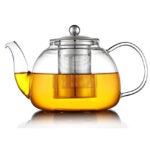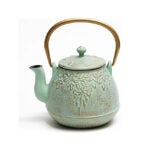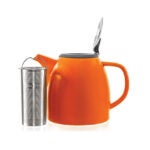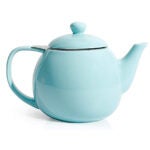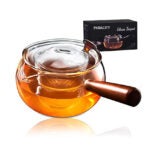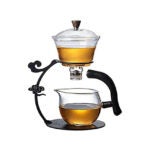How to Pick the Best Tea Pot for Tea Lovers
Are you a tea lover and would love to acquire a new teapot to make your favorite leaf brew? Finding the perfect teapot is not easy, especially when you have hundreds of overwhelming options. Let us show you how to pick the best teapot that perfectly suits your tea-making needs.
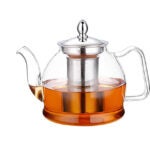
1. HIWARE Glass Teapot – Editor's Choice
- Price Range: $10 – $20
- Capacity: 1,000 ml
- Material: glass
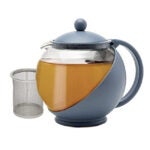
5. Primula Half-Moon Teapot
- Price Range: $10 – $20
- Capacity: 40 ounces
- Material: glass, plastic
Table Of Contents
- Top 8 Best Teapots
- 1. HIWARE Glass Teapot
- 2. DOPUDO Glass Teapot – Runner up
- 3. TOPTIER Tea Kettle – Best cast iron teapot
- 4. Tealyra Teapot – Best ceramic teapot
- 5. Primula Half-Moon Teapot – Budget pick
- 6. Sweese Teapot – Best porcelain teapot
- 7. PARACITY Glass Teapot – Best glass teapot
- 8. RORA Glass Teapot – Best design
- Are Teapots the Same as Kettles?
- Features of a Good Teapot
- Types of Teapots
- Tips for Cleaning and Storing Your Teapot
- Bottom Line
- Frequently Asked Questions
You might want to check: Best Bedtime Tea
Top 8 Best Teapots
1. HIWARE Glass Teapot – Editor's Choice
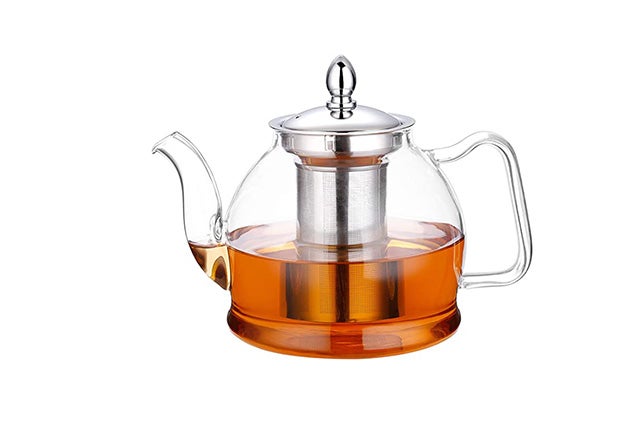
Highlights
- Price Range: $10 – $20
- Capacity: 1,000 ml
- Material: glass
Pros
- Microwave and stovetop-safe.
- Removable infuser.
- Non-dripping spout design.
Cons
- Lid is not microwave-safe.
There’s something about glass teapots that’s very enjoyable. Perhaps it’s the chance to always see the tea inside, and if you’re a true tea lover, it can make your mouth water in anticipation of serving the next cup. This particular teapot is designed to hold up 1,000 ml of tea and is advertised as microwave and stovetop-safe.
It features a removable infuser that holds your favorite tea varieties, and the borosilicate glass offers far greater resistance compared to regular glass. If you wanted a versatile glass teapot that could also be used to serve tea, I think you’ve found the perfect one.
2. DOPUDO Glass Teapot – Runner up
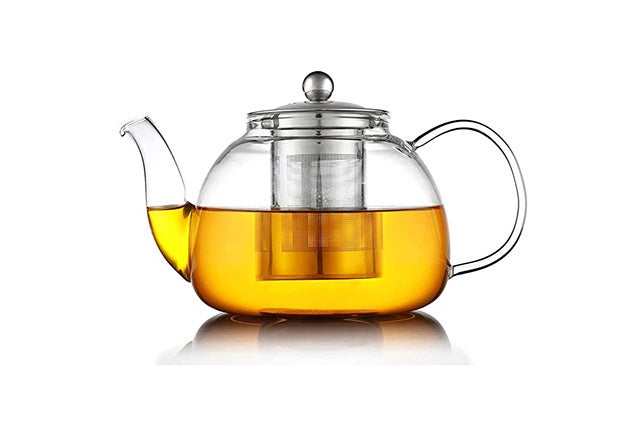
Highlights
- Price Range: $10 – $20
- Capacity: 40 ounces
- Material: glass
Pros
- High-temperature resistance.
- Dishwasher-safe.
- Wide opening, easy to handwash.
Cons
- Questionable long-term durability.
Another great teapot made from borosilicate glass comes from DOPUDO. It is designed with an elegant curves spout and a thin handle with a gap large enough to fit almost any hand size. This would look great on your coffee table as you’re having your friends over for a nice cup of tea.
The borosilicate glass construction is resistant to temperatures as low as 0 degrees and as high as 300 degrees Fahrenheit. It is a dishwasher-safe product that could be placed in the microwave and even used on your stovetop to boil tea water. I could see this being used at an elegant tea party.
3. TOPTIER Tea Kettle – Best cast iron teapot
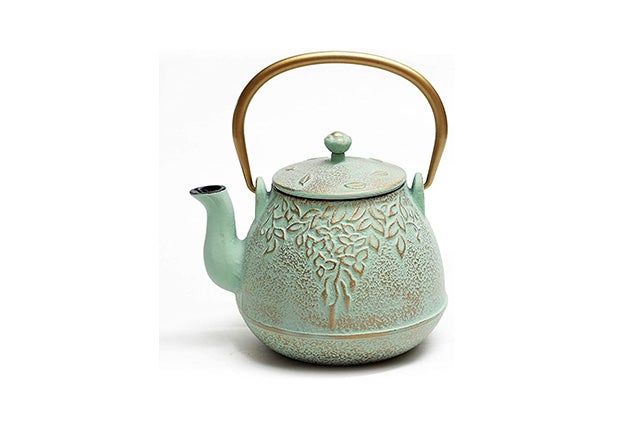
Highlights
- Price Range: $20 – $30
- Capacity: 22 ounces
- Material: cast iron
Pros
- Multiple color options.
- Beautiful design.
- Anti-rust enamel lining.
Cons
- Handle turns hot when on stovetop.
I’m so in love with the gorgeous design of this teapot. You can get this in multiple colors, including some pastel ones with a distressed and gorgeous finish. Whether you opt for lilac or turquoise, every one of these teapots is just adorable. They would just like a French cottage kitchen design or a rustic-inspired tea party.
Each pot has a 22-ounce capacity and is made entirely out of cast iron. Its construction makes it perfect for boiling water on top of the stove but be sure you don’t add more than 17 ounces of water for boiling.
4. Tealyra Teapot – Best ceramic teapot
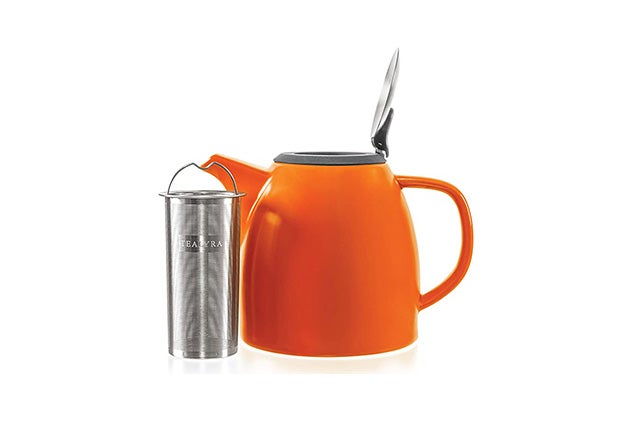
Highlights
- Price Range: $30 – $40
- Capacity: 37 ounces
- Material: ceramic
Pros
- Gorgeous color options.
- Large teapot capacity.
- Hinged lid mechanism.
Cons
- Is not stovetop-compatible.
The ability of ceramic teapots to maintain heat for an extended period, along with their low maintenance and classic good looks, has garnered them much praise. In addition to having all of these fantastic qualities, the Tealyra Daze Ceramic Teapot has tons of color options, so it can be customized to suit the aesthetic preferences of any individual or kitchen.
In addition to having a capacity of 37 ounces, the ceramic body is constructed to withstand high temperatures and the passage of time. A flawless cup of tea is achieved by using a strainer made of extra-fine stainless steel, which captures even the tiniest tea leaves and keeps them from entering the cup. Also, the vivid color choices are a delight when you’re looking for something out of the ordinary.
5. Primula Half-Moon Teapot – Budget pick
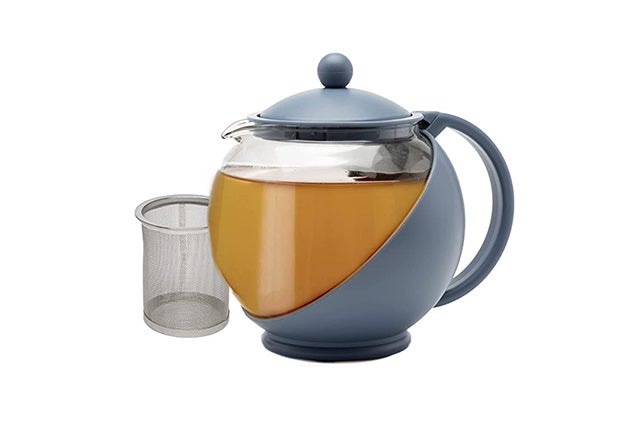
Highlights
- Price Range: $10 – $20
- Capacity: 40 ounces
- Material: glass, plastic
Pros
- Multiple color options.
- All parts are easy to clean.
- Easy to grab and manipulate.
Cons
- Plastic feels of cheap quality.
One of the cheapest teapots you’ll find is this one from Primula. Even so, it isn’t just a low-cost choice. For ease of steeping, this teapot is equipped with a stainless-steel infuser. It holds 40 ounces of your favorite loose-leaf tea.
When compared to most traditional teapots, it stands out right away due to its round silhouette and its exterior which is made up of glass and plastic in equal parts. The design, which is offered in a variety of hues, is favored by many clients, but some individuals may be put off by it.
6. Sweese Teapot – Best porcelain teapot
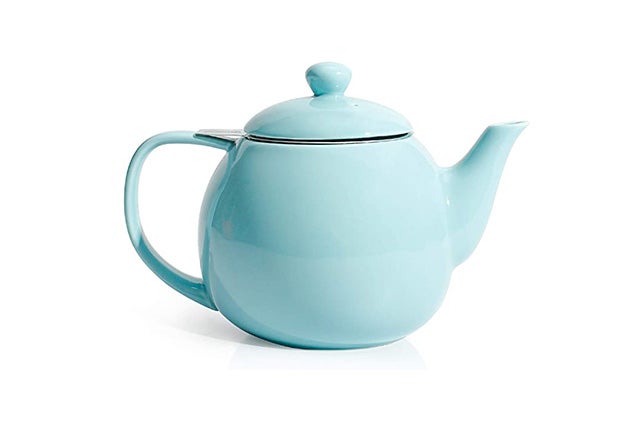
Highlights
- Price Range: $20 – $30
- Capacity: 27 ounces
- Material: porcelain
Pros
- Gorgeous color options.
- Dishwasher and microwave-safe.
- Keeps tea warm for a long time.
Cons
- Lid tends to fall off when pouring.
This teapot has a capacity of 27 ounces and exudes class and charm. The item has a traditional appearance thanks to its round slightly gooseneck spout and round handle, and it can be purchased in a variety of colorful and glossy colors. In addition to that, it features a practical infuser made of stainless steel that can be used with either bagged or loose tea.
At any time, you can boil anywhere from two to three cups of tea, making this a great purchase for a single person. Customers who frequently host gatherings or tea enthusiasts will be glad to learn that Sweese manufactures a nearly identical teapot with a capacity of 40 ounces. The primary difference between the two teapots is that the larger teapot does not come with an infuser.
7. PARACITY Glass Teapot – Best glass teapot
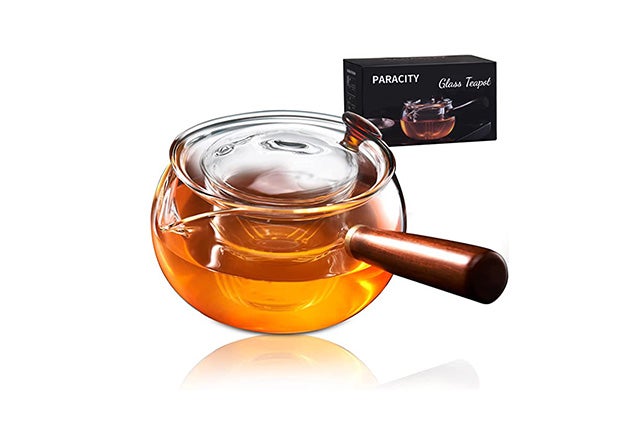
Highlights
- Price Range: $10 – $20
- Capacity: 11.8 ounces
- Material: glass
Pros
- Stovetop-safe.
- Can be cleaned in the dishwasher.
- Easy one-handed operation.
Cons
- It’s very small.
As far as cool and affordable glass teapots go, this has to be one of my favorites. It has such a unique design and can be used on top of the stove, you won’t have to purchase a separate kettle which is a money-saving deal. It’s made with thick borosilicate glass and it looks like the type of product that can withstand serious wear, as well as high temperatures.
I love the wooden handle that makes it easy to grab the teapot even when it’s on top of the stove. It’s made from sandalwood and the combination between wood and glass makes the construction of this teapot gorgeous, to say the least.
8. RORA Glass Teapot – Best design
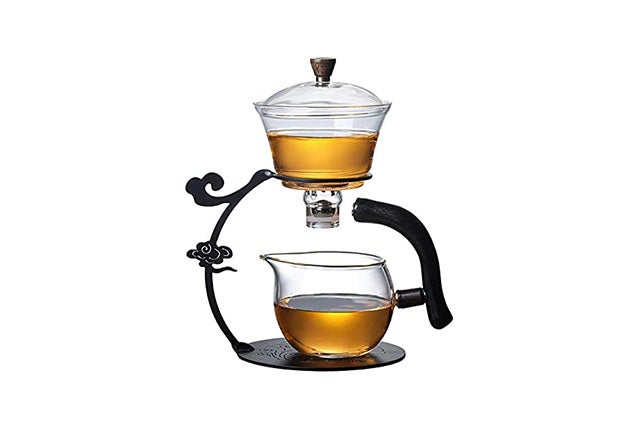
Highlights
- Price Range: $70 – $80
- Capacity: 350 ml lower bowl
- Material: glass
Pros
- Gorgeous design.
- Removable magnetic infuser.
- Parts are easy to clean.
Cons
- Small capacity.
When it comes to the best teapot design, this one takes home the trophy. This ingenious tea brewing pot combines a metal structure with borosilicate glass recipients that make the brewing process itself a pleasure to gaze at. With this centerpiece, you have a real conversation starter when you have guests over for tea.
The pot is structured with an upper glass container that holds the water and the leaves and has a 300 ml capacity. The tea slowly brews and drops into the lower glass pot, which has a 350 ml capacity. While it costs more than the other teapots we’ve seen today, it’s certainly a luxurious-looking product that would make a perfect gift for the tea lover in your life.
You might be interested in: The Best Teas for Sleep
Are Teapots the Same as Kettles?
A teapot is a container that is designed to hold boiling water along with coffee grounds or tea leaves so that the beverage can be steeped, brewed, and easily shared with other people. The purpose of a tea kettle is to bring water to a boil, and this can be accomplished on a stovetop or with an electrical heating element.
Note: Some teapots are compatible with stovetop use but not all. Kettles are always suitable for stovetop use and can sometimes be used as teapots too.
— Teapot Features
You can envision why it would be a bad idea to put a porcelain teapot on top of a gas burner now that you know it would shatter practically instantly in that situation. Most teapots are designed with a particular aperture that is intended to receive boiling water.
Most teapots come equipped with not just a hole for pouring water but also a practical spout for pouring tea as well as a strong handle. There is a possibility that the spout comes equipped with a strainer that prevents any coffee grounds or bits of leaves from falling into the cup.
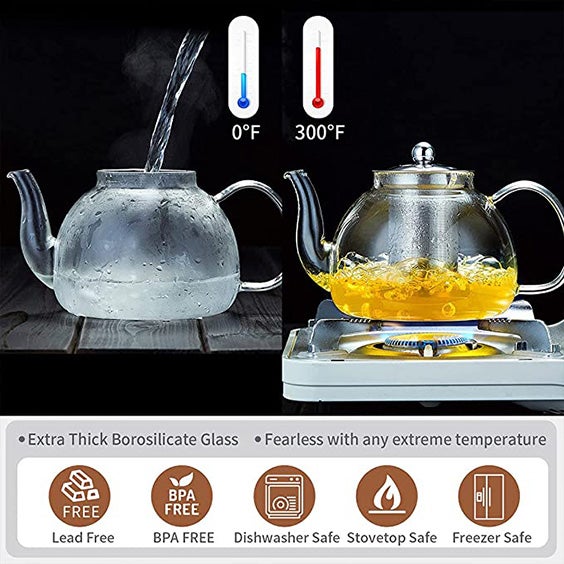
Because of the teapot’s fragility, it should never be used on top of a stove. When you are on the market for new home appliances for your kitchen, this is perhaps the single most crucial consideration to keep in mind. Although they are wonderful for infusing tea or coffee and presenting it, you should never use them to boil the water that is required.
— Tea Kettle Features
Since you now know that the teapot’s sole purpose is to contain your beverages while they are being steeped, you can probably anticipate that the tea kettle’s job is to bring the water to a boil. In contrast to their counterparts, teapots are typically made of ceramic, which cannot withstand high temperatures, but tea kettles can.
Tea kettles designed for use on stovetops are compatible with both gas and electric ranges, so you may brew your tea regardless of whatever sort of range you have in your home. However, there is a drawback to this sort of kettle, and that is the fact that it requires more time to heat up and uses more energy overall. However, the cost savings are typically greater.
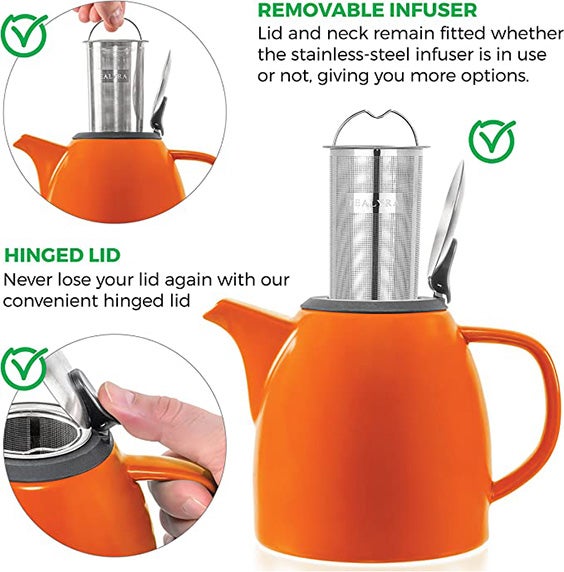
Electric tea kettles heat water without the necessity of a stovetop because they are powered by electricity. Because of how they’re constructed, these tea kettles can bring water to a boil quickly; some of them can do so in as little as 30 to 60 seconds.
These kettles are more expensive than their stovetop counterparts, but the speed with which they heat water and their low energy use make them a worthwhile investment. Certain electric versions can have additional helpful features, such as the ability to control the temperature.
Features of a Good Teapot
Considering these tips before you buy.
— Materials vs. Taste
The flavor of the tea can also be affected by the type of teapot that is used. Some of the types of containers that are not likely to alter the flavor include glass jars and ceramics without pores. There are many possible explanations for why cast iron, stainless steel, and porous ceramics can affect the flavor of food.
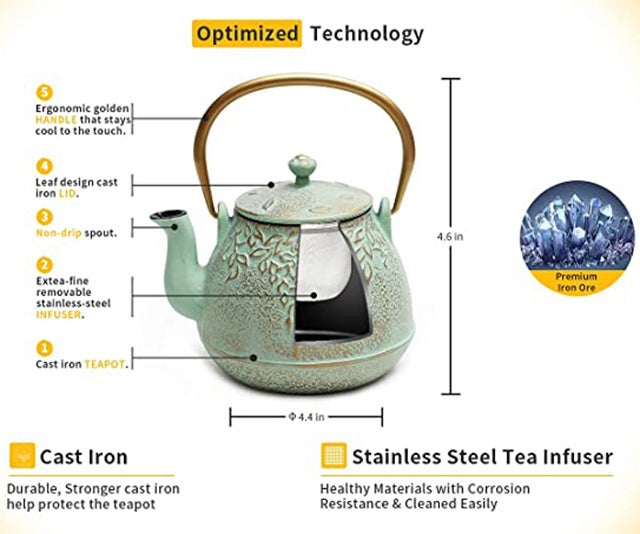
To begin, you should always purchase teaware that is of high quality and is risk-free to use. There is a possibility that the components used in the production of very inexpensive teapots are unsafe or that they will deteriorate over time.
Next, teapots made of metal are susceptible to rusting if they are not made of stainless steel. The teapot made of porous ceramic is the best one you can buy for your tea, but you can only use it for brewing a single variety of tea at a time.
— Strainers
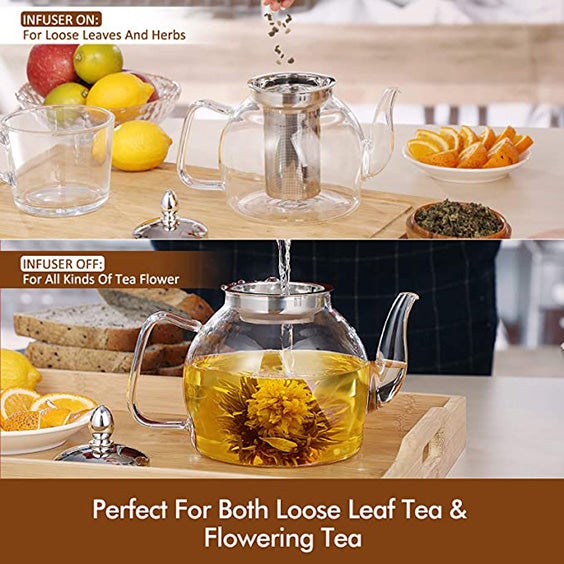
Some teapots come with detachable metal or ceramic filters, while others have built-in strainers made of metal or stainless steel, others have filters with holes on the inside, and others do not have a filter at all.
For loose leaf tea with larger leaves, you should use a teapot that has holes in the interior. Built-in metal filters may be an excellent solution for capturing fine particles, but they may be challenging to clean. Filters made of removable metal mesh can typically be used with virtually any kind of tea, including rooibos.
— Temperature Control
Even though some of the cups have lids, the tea that is brewed in them does not have a pleasant flavor. The controls for the temperature are the source of the issue.
As we make tea, we determine the brewing time based on the different types of tea. The temperature of the tea leaves will not rise any higher if they are allowed to remain in the teapot, and the flow of cool air will cause them to become cooler.
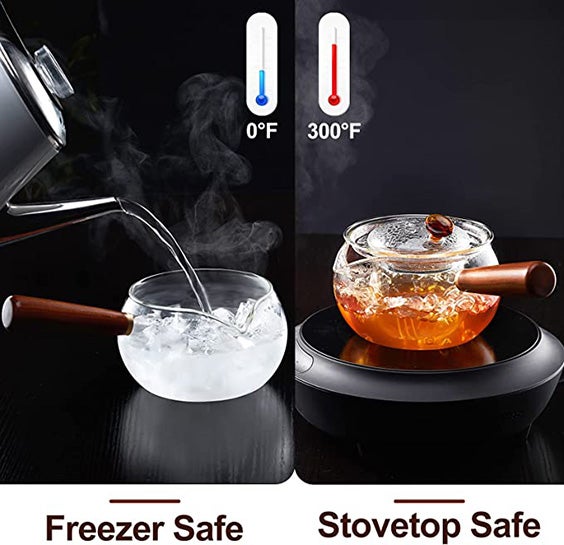
When using the cups, the tea leaves will remain warm because the hot water will continue to flow over them until you have finished drinking. The continual and excessive cooking will result in a change in the flavor of the tea. Especially when you use green tea that hasn’t been fermented, the infusion you make will turn a dark yellow color and taste like a tea stain.
Temperature control performance is also impacted by the material that the teapots are made of. For example, teapots made of metal, which has high thermal conductivity, can cause the tea to become colder more quickly. Teapots made of porcelain or ceramics, which have a low thermal conductivity, can keep the tea warm for a longer period
— Handles
The handles can be placed on the top, sides, or back of teapots. Handles are typically located on the sides of larger teapots, whereas handles for smaller teapots are typically located on the lids.
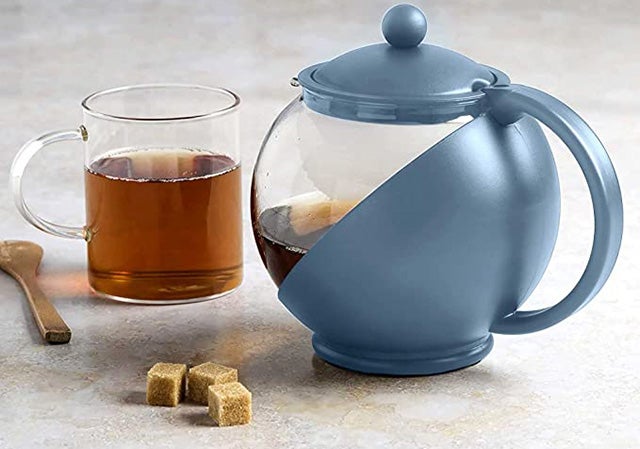
What’s surprising is that there’s an entire science when it comes to the gap between the teapot and the handle. When you grab the teapot’s handle and your knuckles are not contacting the surface of the teapot, you have discovered the proper one. This means you can pour tea without scalding your fingers. This will simplify things on your end.
Always make sure to test the handle of the teapot you want to buy by lifting it and seeing if it feels comfortable. Check to see if the weight of the teapot is proportionate to the strength of the teapot as well.
— Spout
The spout is another aspect that needs to be examined because it is this component that decides whether or not the pour will be neat. If the spout of the teapot is too close to the rim of the teapot, your hand is going to get burned by the steam that is escaping from the spout. In addition to this, check to see that the tip of the spout is leveled with the pot’s rim.
— Size
If you only ever make yourself one cup of tea at a time, you might not want to keep a large teapot that takes up a lot of room inside the cabinets or on the countertop.
A small pot is ideal for those who only need to brew one or two cups of tea at a time, which is the case for the majority of people. If, on the other hand, you have a larger household or like to have friends over for tea, you might want to think bigger.
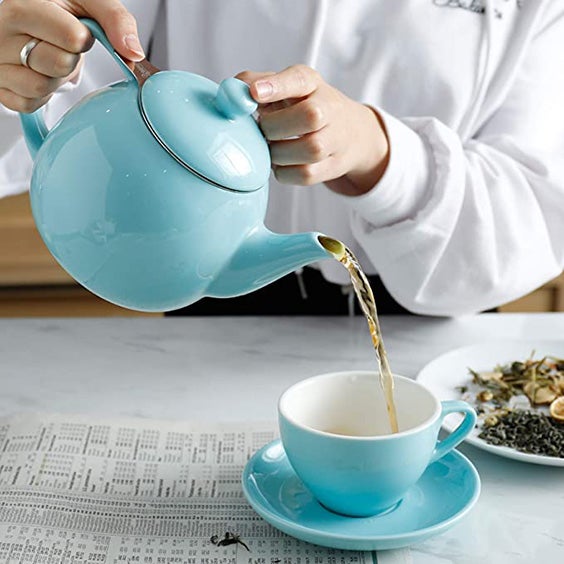
You also need a large teapot if you enjoy drinking tea multiple times throughout the day. A large teapot will allow you to have multiple cups of tea prepared so you can just serve them whenever you feel like it.
— Design
You are going to be staring at your teapot each time you have a cup of tea, so you should try to find one that is aesthetically pleasing in addition to doing an excellent job of boiling tea. Glass teapots are beautiful to look at. Especially when used to brew blooming teas, which, as the tea steeps in hot water, reveal their full beauty to the observer.
Experiencing anything less than a beautiful moment while seeing them impart their color and flavor into the water can be unthinkable.
Even if you choose the ones made of pottery, cast iron, or clay, you can choose from a wide variety of stylish and colorful teapots that are available to fit your preferences. The ceramic ones are available in an impressive variety of designs and colors to choose from.
— Lid
To prevent the steam from escaping along with the scents and flavors of the tea, the lid needs to have an appropriate fit on the rim of the container. A little hole is drilled into the top of the pot’s cover so fresh air can enter the container while the tea is poured into individual cups.
Because this minute hole controls the flow of tea out of the pot, the beverage does not go flying all over the place when it is poured. A quality lid that has a hole in it forms a seal for the teapot, preventing steam from escaping while at the same time enabling the tea to be poured out of the pot while it is still scorching hot.
Types of Teapots
Teapots are divided into categories based on what materials they’re made from.
— Ceramic
There is a wide variety of ceramics that can be used to make teapots, including porous ceramics and stoneware. Yixing is home to some of the world’s most renowned porous and unglazed ceramic teapots.
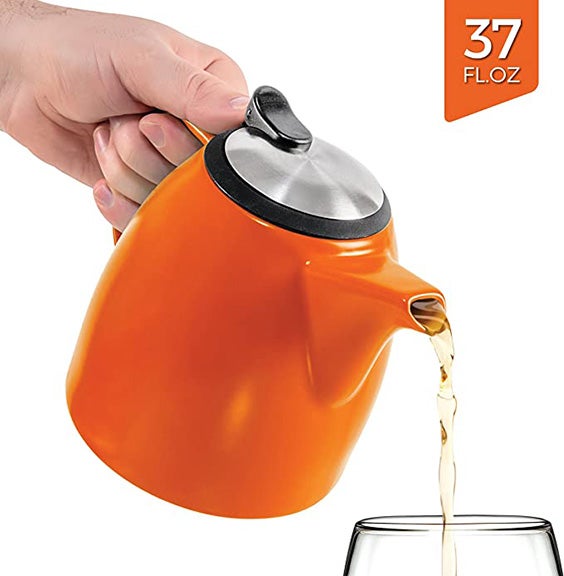
They are excellent for producing oolong raw pu’erh teas and are formed of purple clay known as zisha. Because tea is brewed in them, they may acquire a very thin layer of coating on the inside over time. Because of this, you should never use them for more than one kind of tea at a time.
Stoneware is the other form of pottery, and unlike earthenware, it is non-porous. This property makes it suitable for brewing a variety of teas. Porcelain is another form of ceramic; but, due to its delicate nature and high level of sophistication, it must be handled with extreme caution.
— Glass
Your collection of teapots will benefit tremendously from the addition of a quality glass teapot. They are wonderful for brewing virtually any kind of tea, but they are absolutely necessary for flowering teas. A glass teapot will provide you with the opportunity to admire the unfolding of the tea leaves.
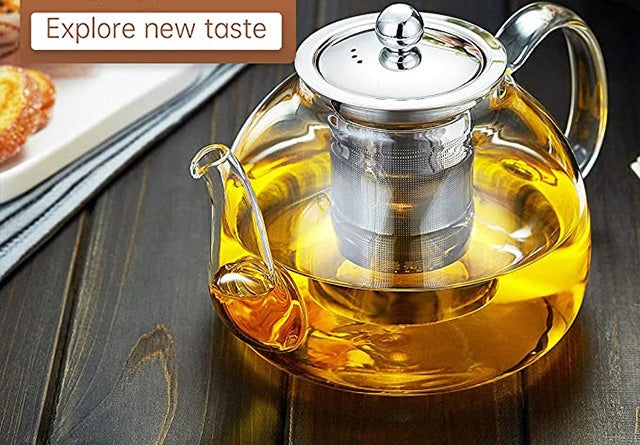
Teapots made of glass can be found in a variety of sizes and shapes. They might have filters made of glass or metal, or they might not have any filters at all. The greatest types of tea to brew in a glass teapot include ball-shaped oolongs like Ti Kwan Yin, flowering tea, Dragon Well, and a variety of other green teas. These types of teas produce the most flavorful brews.
— Metal
Metal teapots are usually made from stainless steel or cast iron. The ability of stainless-steel teapots to maintain heat may be their most significant benefit. This implies that your tea will keep its temperature for a longer period than it would in a glass teapot.
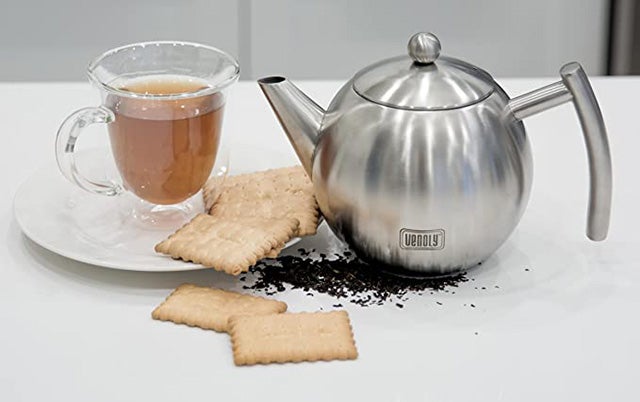
It is also the most long-lasting substance because it does not shatter when dropped and does not crack when exposed to boiling water.
A tetsubin is a Japanese-style teapot and is the best illustration of what a cast-iron teapot should look like. On the other hand, not every tetsubin is a teapot. In the past, tetsubins were used to boil water because they altered the flavor of the water and made the tea taste better.
Cast iron teapots aren’t suitable for boiling water because they have an enamel coating, so they are more suitable for brewing.
Tips for Cleaning and Storing Your Teapot
Cleaning a teapot can be accomplished in a variety of ways, the majority of which, fortunately, are speedy and uncomplicated.
- It’s best to flush the interior of your teapot with hot water after every use to get rid of any residue.
- To avoid limescale, you should give the area an intensive cleaning around once every two weeks.
- Depending on the material that your teapot is constructed from, you can clean it with any one of several common home materials, such as lemon juice, baking soda, or vinegar.
- The teapot only requires minimal cleaning with soap and water and rinse.
- After allowing the mixture to rest for about half an hour, empty the teapot and scrub the interior with a clean towel or brush.
- Don’t use coarse cleaning brushes on cast iron teapots because they can damage the product.
You might want to read: 15 Quick and Easy Tea Recipes For Better Sleep
Bottom Line
No ideal formula tells you how to pick the best teapot because it depends on what you need. It depends on how much you drink throughout the day, what design suits you the best, whether or not you intend to boil the water separately, and how much money you’re willing to spend on a new teapot. Check out our guide to the best bedtime teas to go in your new teapot!
Frequently Asked Questions
A teapot is designed for brewing tea, which means you can put any tea you like inside it. You can also put hot water to start brewing.
The glass cup will lose its heat more quickly than the ceramic cup because the wall of the ceramic cup is thicker. Because it is made of glass, the cup allows you to view the tea as it steeps. A visible indicator makes it easier to keep an eye on the tea as it steeps. Ceramic is a more forgiving material than glass; hence, the cup is less prone to break.
It is possible to use a French press to make tea. It works best when trying to brew loose leaf tea. You’re also going to need a kettle to boil the water before making the brew.

